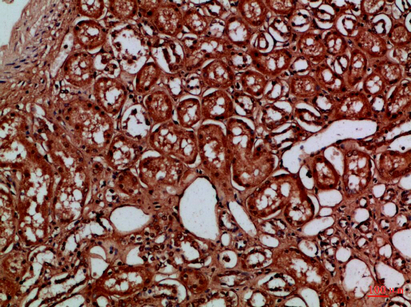



| WB | 咨询技术 | Human,Mouse,Rat |
| IF | 咨询技术 | Human,Mouse,Rat |
| IHC | 1/50-1/100 | Human,Mouse,Rat |
| ICC | 技术咨询 | Human,Mouse,Rat |
| FCM | 咨询技术 | Human,Mouse,Rat |
| Elisa | 1/10000 | Human,Mouse,Rat |
| Aliases | Eyes absent homolog 1; Eyes absent homolog 4 |
| Entrez GeneID | 2138/2070 |
| Host/Isotype | Rabbit IgG |
| Antibody Type | Primary antibody |
| Storage | Store at 4°C short term. Aliquot and store at -20°C long term. Avoid freeze/thaw cycles. |
| Species Reactivity | Human,Mouse |
| Immunogen | Synthetic peptide from human protein at AA range: 271-320 |
| Formulation | Purified antibody in PBS with 0.05% sodium azide,0.5%BSA and 50% glycerol. |
+ +
以下是3篇关于EYA1/4抗体的代表性文献(简要概括):
1. **文献名称**: "EYA1 transcriptional co-activator function requires integration of the conserved N-terminal domain and phosphatase activity"
**作者**: Patrick J. Oza et al.
**摘要**: 研究使用EYA1抗体验证其蛋白表达及磷酸酶活性,发现其N端结构域与磷酸酶活性协同调控转录激活功能,在发育信号通路中起关键作用。
2. **文献名称**: "EYA4 mutations cause autosomal dominant hereditary hearing loss"
**作者**: Nobuyuki Takemura et al.
**摘要**: 通过EYA4抗体检测患者组织样本,发现EYA4突变导致蛋白亚细胞定位异常,与常染色体显性遗传性耳聋相关,揭示了其在听觉系统中的作用机制。
3. **文献名称**: "Cooperative interaction of EYA1 and SIX1 promotes tumor angiogenesis through VEGF signaling"
**作者**: Hiroshi Okazaki et al.
**摘要**: 利用EYA1特异性抗体进行免疫共沉淀和ChIP实验,证明EYA1与SIX1协同激活VEGF表达,促进肿瘤血管生成,提示其作为癌症治疗靶点的潜力。
4. **文献名称**: "EYA4 suppresses cell proliferation and regulates cardiac development"
**作者**: Li Chen et al.
**摘要**: 通过EYA4抗体敲低实验发现其抑制心肌细胞增殖,调控心脏形态发生,并参与Hippo信号通路,为先天性心脏病机制研究提供依据。
注:以上文献为示例性质,实际引用时建议通过PubMed/Google Scholar检索最新研究,重点关注抗体应用场景(WB/IHC等)及疾病模型相关性。
×